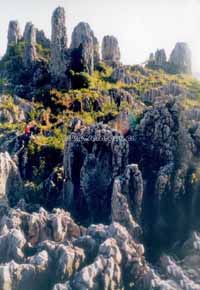| Tools: Save | Print | " target="_blank" class="style1">E-mail | Most Read |
| Xingwen Karst Geological Park Opens to Public |
| Adjust font size: |
|
The Xingwen Karst Geological Park, approved to be a national geological park by the Ministry of Land and Resources, has formally opened to tourists as a state-level scenic spot. Located in Xingwen County in southwest China's Sichuan Province, the park lies in the transitional zone between the Sichuan Basin and Yunnan-Guizhou Plateau. Within the park, limestones of different ages are widely distributed. The so-called Xingwen-type karst landform is formed under the specific geographical position, unique geological structural setting, climate and environment. The park is the site where the giant doline, a closed depression draining underground water in karst areas, was first studied and named in China. It is one of the most important places for karst landform research in the country, said Liu Baojun, academician of the Chinese Academy of Sciences. Carbonate or carbonate-bearing strata dated from about 490 to 250 million years ago are well preserved in the park. There is an abundance of marine fossils and sedimentary marks in the strata, which are the basic materials to form specific landforms with scientific value, Liu said. Covering 156 square kilometers, the park, hailed as a natural research museum, is also known for its beautiful natural scenery and unique cultural heritage.
The Bo, known to many for their mysterious hanging coffins on high cliffs along some sections of the Yangytze River, inhabited the area for more than 1,000 years in Xingwen before they were slaughtered out of existence some 500 years ago in a genocide in the aftermath of a war between them and the ruling Ming Dynasty (1368-1644). Hanging coffins, group of tombs, ancient castle, castle gates, stone inscriptions and copper drums of the Bo are preserved in the park. Despite its rich tourist attraction, Xingwen, which used to be a poverty-stricken county, had few visitors who came to view the wonders because of inadequate investment and publicity. The park, which opened to visitors in 1980, received an investment of less than 3 million yuan (US$363,000) from 1980 to 2001. To develop the tourism industry and help more locals beat poverty, the county decided to apply for national geological park status. Since 2002, it has raised funds totalling 83 million yuan (US$10 million) to build infrastructure, closed all polluting factories and returned 7,533 hectares of farmland to forests in the park. The efforts have paid off, said Lan Xiangyi, magistrate of Xingwen. Despite the SARS epidemic of 2003, the county's tourism earnings surpassed 20 million yuan (US$2.4 million) last year, four times the figure for the previous year.
(China Daily November 15, 2004) |
| Tools: Save | Print | " target="_blank" class="style1">E-mail | Most Read |
 |
| Related Stories |


